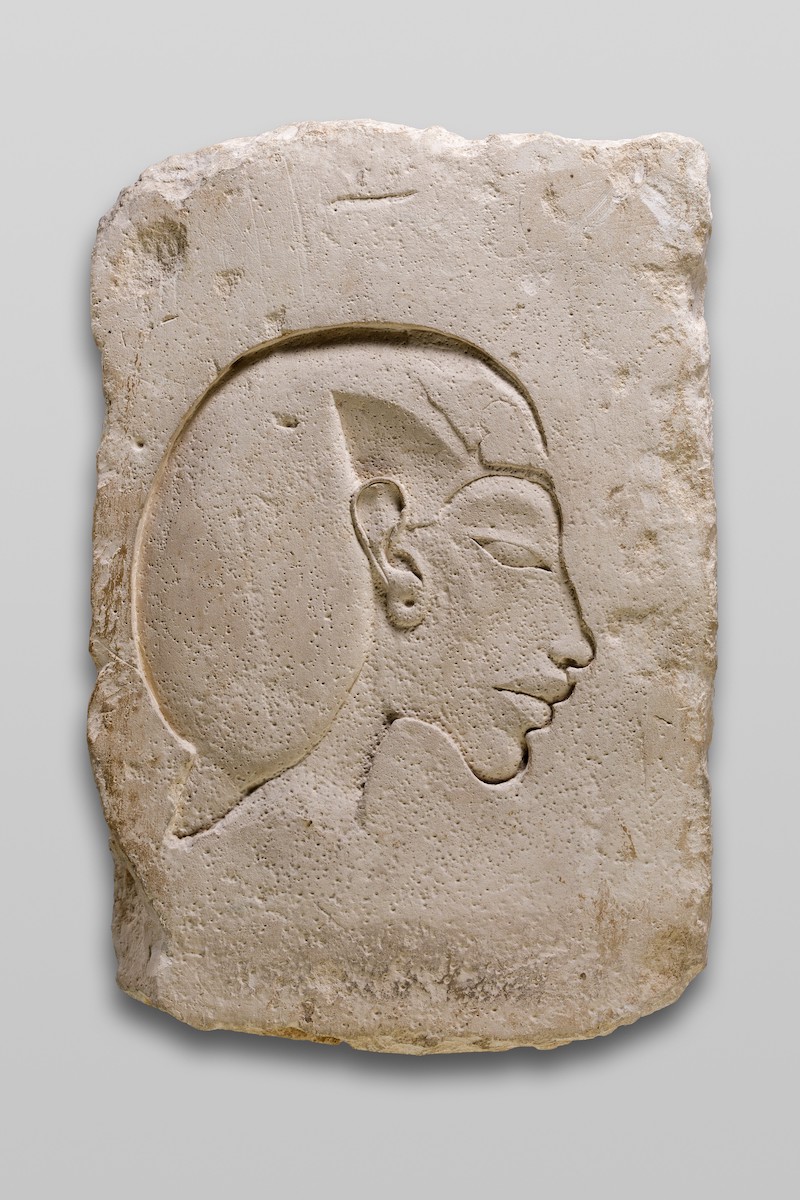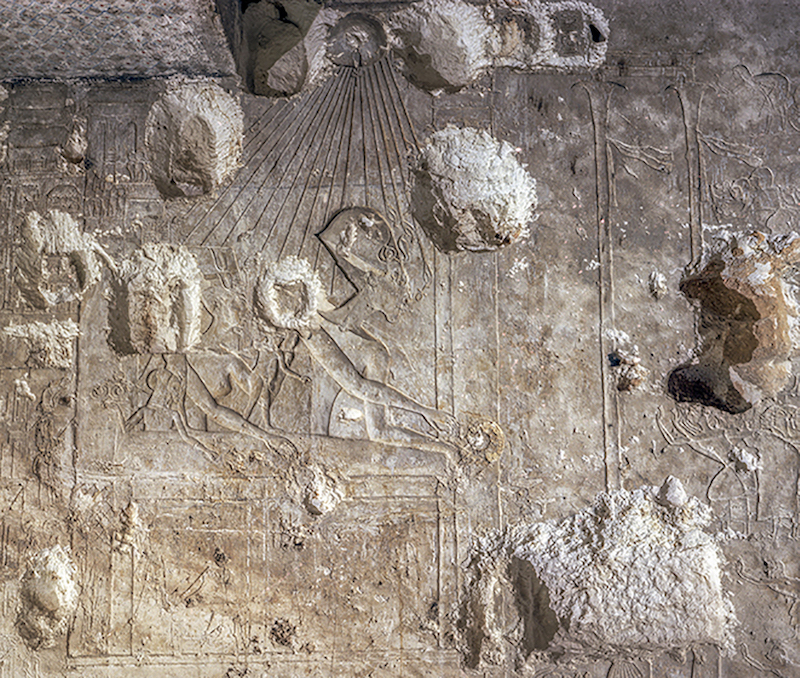The House Altar Depicting Akhenaten Nefertiti Change in Art
The reign of King Akhenaten stands out in ancient Egyptian history for artistic innovation, the creation of a new religious upper-case letter and intrigue surrounding royal succession. Above all, though Akhenaten is known for his development of a kind of early monotheism that stressed the uniqueness of the sun god Aten, and of Akhenaten'south ain human relationship with this god. For this king, there was only one god and simply one person who at present knew the god: Akhenaten himself.
Initially chosen Amenhotep IV, Akhenaten came to the throne around 1349 BCE. He spent his early years as male monarch engaged in fairly traditional building projects, including at the great Karnak Temple, home of Amun, and in the aureate-rich land of Kush (Nubia) to Egypt'south southward. Late in his tertiary year of rule, however, he took the extraordinary step of celebrating a Jubilee Festival, a ritual renewal of kingship usually held after 30 years on the throne. At Karnak, Akhenaten constructed a series of Jubilee buildings withtalatat, minor stone blocks that became a signature of his reign.
Initially, the rex's edifice projects embraced a range of cults, including that of the Aten - shown at the time as a falcon-headed human. But the Karnak Jubilee buildings featured the Aten solitary and represented in a new form: as the disc of the dominicus, its rays ending in hands reaching out to the majestic family.
One of the Karnak buildings was too busy with striking, jumbo statues of the male monarch with heavily exaggerated and androgynous features: drawn-out confront, broad hips and distended belly. These statues set up the king autonomously from the mortal earth and highlighted his part every bit a divine provider of fertility and prosperity, like the Aten.
Another of the Karnak buildings showed the Aten not with Akhenaten but with his queen, Nefertiti, and the purple daughters. The Aten cult afforded a special place to purple women, particularly Nefertiti, who was linked with Akhenaten and the Aten in a divine triad. The three were assimilated with the divine figures in ane of Egypt'due south most important creation myths: the birthing of the twins Shu and Tefnut from the androgynous creator god Atum. Royal women helped to legitimize the Aten cult. They stood in for goddesses in contexts where female divine power was needed, and so became semi-divine themselves.
Akhenaten's promotion of the Aten cult presently intensified. He changed his name from Amenhotep to Akhenaten - 1 Who is Effective for the Aten - and redirected revenue from Egypt's temples into the Aten cult. Teams of workers were dispatched to chisel out the names and images of other gods from the walls of monuments. Amun, Mut and Khonsu, the patron gods of Thebes, were specially targeted. This removal work was frequently sloppy and incomplete, only information technology must surely have been an affront to Egypt's religious institutions.
In the fifth year of his reign, Akhenaten appear plans to create a new cult loonshit entirely for the Aten. He chose a place halfway betwixt Memphis (Cairo) and Thebes (Luxor) and named it Akhetaten - Horizon of the Aten. The site is known today as Amarna. Whether driven by religious fervor or a political desire to distance himself from the priesthood of Amun, Akhenaten'due south abandonment of Thebes was a remarkable step away from the status quo.
Akhetaten grew apace into a large, sprawling city on the e bank of the Nile River. Vast temples were dedicated to the Aten, left unroofed to be filled with light - thus eliminating the demand for cult statues of the god. Offerings of bread, beer, cattle, fowl, wine, fruit and incense were given to the sun god on open-air altars. As the sun moved e-w over the temples, Akhenaten traveled n-south through the metropolis in a aureate chariot as the Aten's representative on world.
Akhenaten's palaces and temples were decorated with scenes from the natural globe, including birds, frolicking calves and river plants, celebrating the life-giving aspects of the Aten. Reliefs, paintings and statues of the royal family adorned cult buildings, less farthermost in mode than the early Karnak colossi just frequently still fluid and exaggerated. Occasionally the royal family was depicted kissing and embracing.
Around the city'south outskirts, Akhenaten congenital at least four Sunshade of Re temples dedicated to royal women, where the king continued with the regenerative powers of the dominicus god. In a valley deep in the eastern cliffs, he created a new purple burial ground. Loyal officials were granted space in the cliff face for their ain thousand tombs. Hoping for an afterlife in the company of the sun god, they historic the cult of the Aten and the divine king through scenes and texts carved on the tomb walls. These included the famousHymns to the Aten, in which the Aten is presented as the creative ability of light. TheHymns stress that the Aten is the only god, encompassing concepts of beauty, love and fatherhood.
Today, the ruins of Akhetaten at Amarna course a remarkable archaeological site: one of the most intact cities to survive from the ancient world and one containing the houses, temples, palaces, streets and cemeteries of a unmarried generation. Archaeological work here has focused not only on the Aten cult but also on the lives and experiences of Akhenaten'due south people. Ongoing fieldwork by the Amarna Projection at the city'southward not-elite cemeteries, for example, has shown that difficult working lives and poor diet were common, although whether these conditions were more or less extreme at Akhetaten is still unknown. The cemetery excavations also have yielded coffins busy with images of traditional funerary deities, suggesting that not anybody followed the rex in abandoning the gods.
The occupation of Akhetaten was ultimately to be brusque-lived. After 17 years on the throne, Akhenaten died of causes now unknown. He was buried in the Amarna Imperial Tomb, where his daughter, Meketaten, and mayhap his mother, Tiye, had already been interred. The Amarna menstruum was followed by a quick succession of reigns, the details of which remain hazy.
In his final years, Akhenaten seems to have shared the throne with one or more than family members. One of these was Smenkhkare, possibly the son or brother of Akhenaten, who was married to the king's daughter, Meritaten. Smenkhkare appears only briefly in the historical tape.
Nefertiti also seems to have taken the throne under the name Neferneferuaten. Details of her rule are also frustratingly scarce. She may have ruled briefly with Akhenaten, reigned alone in her ain name or served every bit coregent in the early years of Tutankhamun's reign. In whatsoever case, her fourth dimension on the throne lasted simply a few years. The Royal Tomb at Amarna contains a prominent but unfinished side bedroom that was likely intended for Nefertiti'due south tomb simply it was never used. A young Tutankhaten (after Tutankhamun) next causeless the throne. He was likely Akhenaten'south son. Within a few years, probably led past influential officials, he shut down Akhetaten,relocated the royal court to Memphis and announced the restoration of traditional cults. Around this time, the Amarna regal burials were moved to Thebes. After Tutankhamun's early decease, the official Yep took the throne, followed past Horemheb, a military machine general from Memphis. From Horemheb's reign onward, the g stone buildings at Akhetaten were dismantled to go out footling of Akhenaten's initiatives.
Akhenaten left a complicated legacy. To later Egyptian kings, he was a heretic whose name and family were excluded from official king lists. Today, views of him are more diverse and sometimes more sympathetic. In any instance, Akhenaten's momentous reign challenges us to consider how and why spiritual and societal changes occur, whether in ancient Egypt or whatsoever land.
Recommended Reading
D. Arnold. 1996. The Majestic Women of Amarna: Images of Dazzler from Ancient Egypt. Metropolitan Museum of Fine art.
A. Dodson. 2014. Amarna Sunrise: From Aureate Age to Age of Heresy. AUC Press.
A. Dodson. 2018. Amarna Sunset: Nefertiti, Tutankhamun, Ay, Horemheb, and the Egyptian Counter-Reformation (revised edition). AUC Press.
R.E. Freed, Y. J. Markowitz & S.H. D'Auria, eds. 1999. Pharaohs of the Sunday: Akhenaten, Nefertiti, Tutankhamen. Museum of Fine Arts, Boston.
B. Kemp. 2012. The City of Akhenaten and Nefertiti: Amarna and its People. Thames and Hudson.
D. Montserrat. 2000. Akhenaten: History, fantasy and ancient Egypt. Routledge.
N. Reeves. 2001. Akhenaten: Egypt's false prophet. Thames and Hudson.
Source: https://www.arce.org/resource/akhenaten-nefertiti-aten-many-gods-one




0 Response to "The House Altar Depicting Akhenaten Nefertiti Change in Art"
Post a Comment